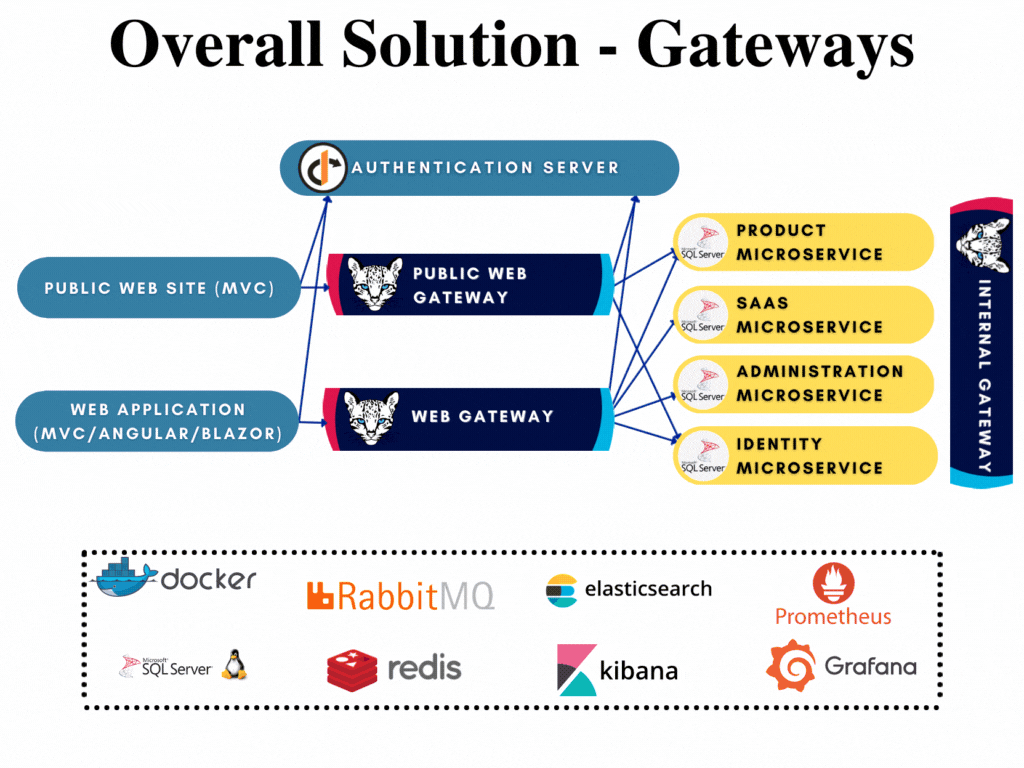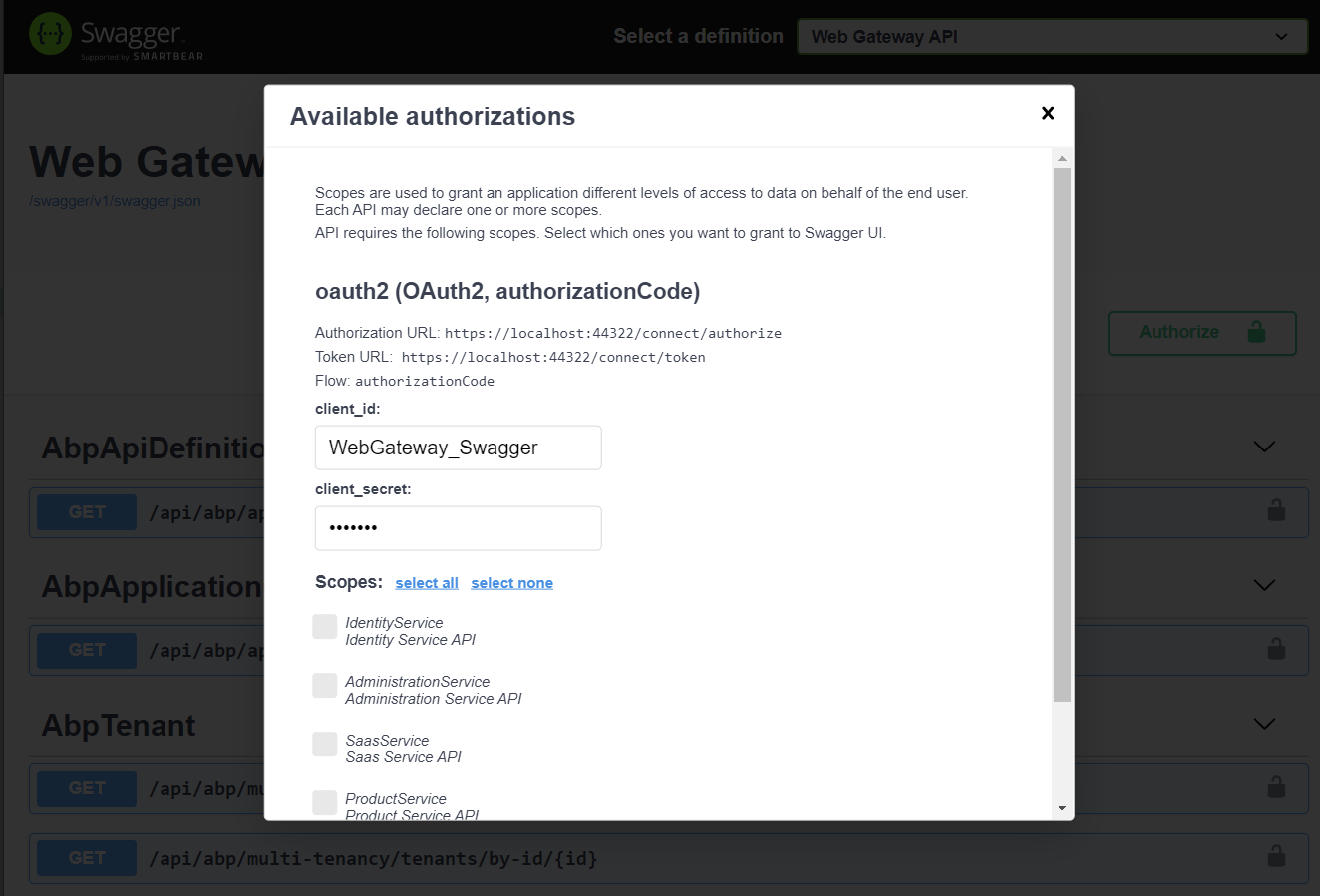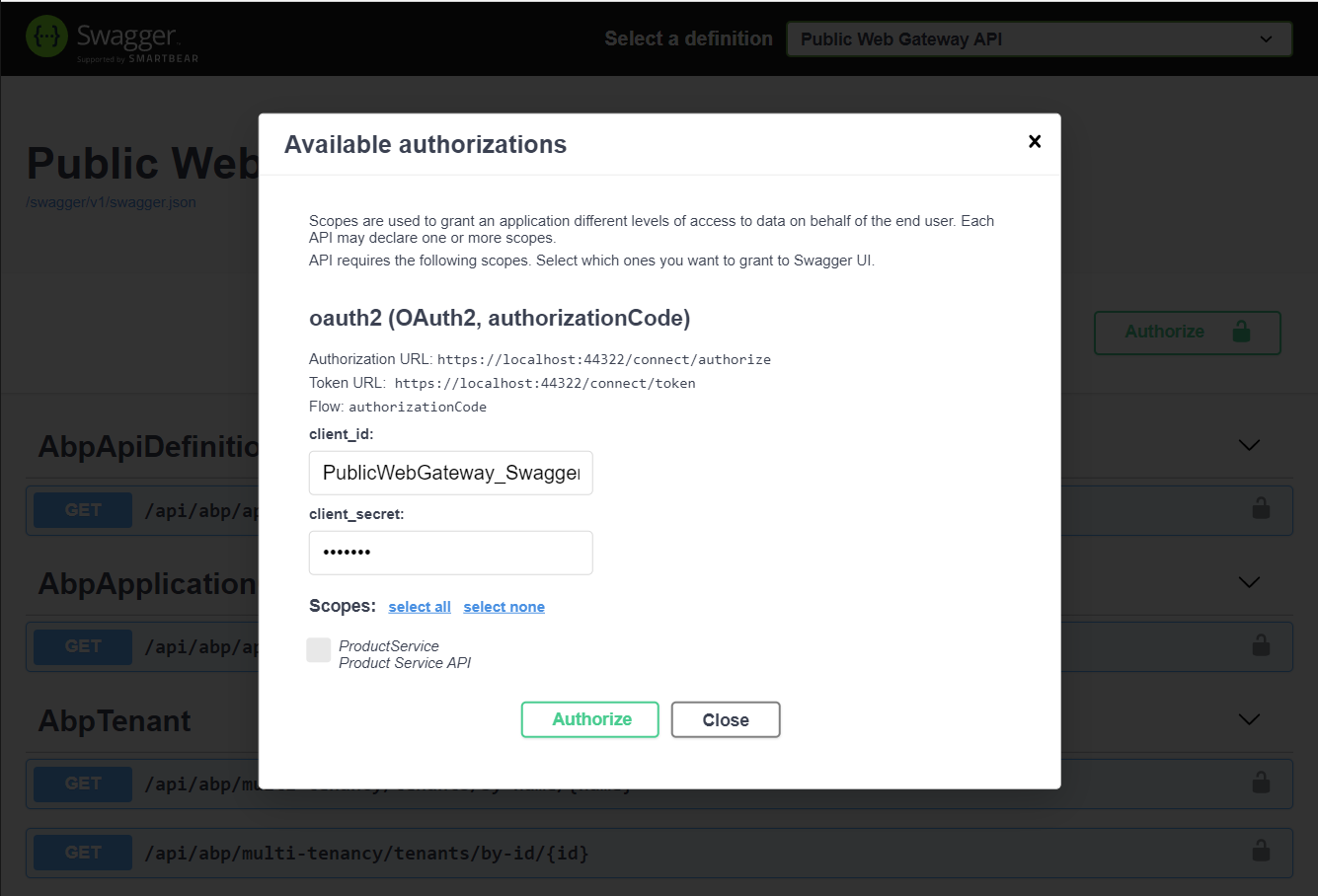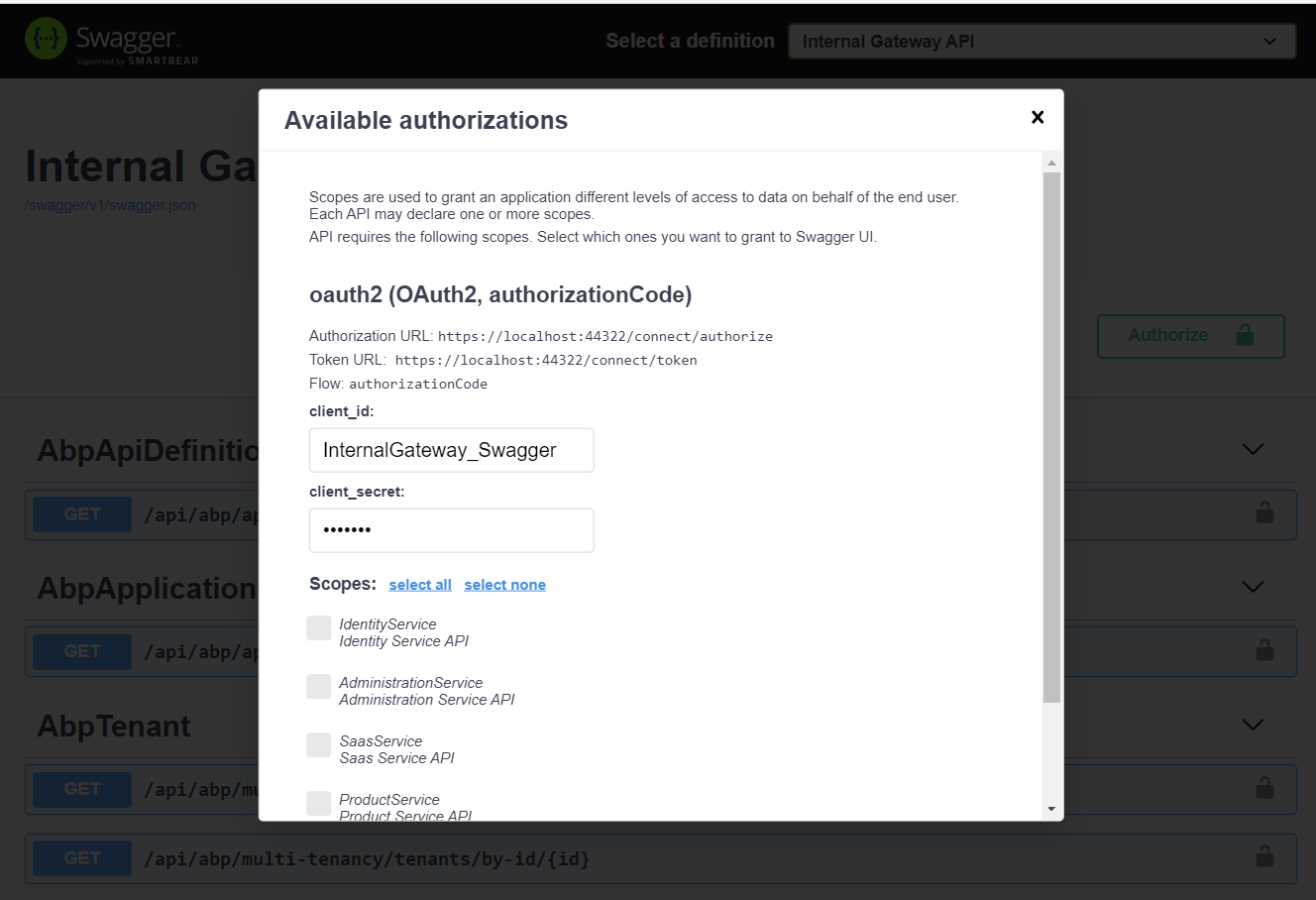Microservice Startup Template: API Gateways
API Gateways are used as single entry point to the microservices. ABP microservice startup template uses Ocelot .Net Api Gateway library. Through this library, gateways have the functionality of routing; rate limiting, retry policies etc. For more, check out Ocelot Documentations.
There are 3 different gateways are presented in the microservice startup template;
- Web Gateway is located under gateways/web folder. This API Gateway uses BFF pattern and redirects requests from Web application (MVC/Agular/Blazor) to Authentication Server or microservices.
- Public Web Gateway is located under gateways/webpublic folder. This API Gateway also uses BFF pattern and redirects requests from Public Web application to Authentication Server or microservices.
- Internal Gateway is located under gateways/internal folder. This API Gateway is used between microservices for inter-communication.
All gateways has their respected solutions created already and can be developed further when if required without opening the whole template solution. The following image shows the gateway highlighted in the overall solution diagram:
To compare microservice template to tiered application template: Gateway is an API.Host project that proxies all the requests to related microservices.
Gateways are depended to HttpApi layer of the microservices they are redirecting to.
All gateways depends on SharedHostingGatewayModule which implements default Ocelot and Swagger with authorization configuration (see the Shared Modules section).
Backend for Frontend Pattern (BFF)
While API Gateway provides a single point of entry to system, Backend for Frontend pattern defines each client with an individual API. The Microservice solution template uses BFF pattern thus each application has its own web gateway.
If you are planning to add your custom client (such as mobile application), it is recommended to add a new gateway for that specific client since each client's requests will probably be different.
Web Gateway
Web Gateway is used to connect the Web (back-office) application to microservices. This is done by setting this gateway as default RemoteService in Web application appsettings.
Module Configuration and Routing
As default, this gateway proxies each request to related microservice and redirects the account related requests to AuthServer;
IdentityService: Depends on
IdentityServiceHttpApiModuleand re-routes/api/identity/{everything}/api/identity-server/{everything}/api/account-admin/{everything}
to
localhost:44388(IdentityService) in appsettings configuration.AdministrationService: Depends on
AdministrationServiceHttpApiModuleand re-routes/api/abp/{everything}application configuration endpoint/api/audit-logging/{everything}/api/language-management/{everything}/api/text-template-management/{everything}/api/feature-management/{everything}/api/permission-management/{everything}/api/setting-management/{everything}/api/lepton-theme-management/{everything}
to
localhost:44367(AdministrationService) in appsettings configuration.SaasService: Depends on
SaasServiceHttpApiModuleand re-routes/api/saas/{everything}
to
localhost:44381(SaasService) in appsettings configuration,ProductService: Depends on
ProductServiceHttpApiModuleand re-routes/api/product-service/{everything}
to
localhost:44361(ProductService) in appsettings configuration.AuthServer: Depends on
AbpAccountPublicHttpApiModuleand re-routes/api/account/{everything}(login page etc requests)
to
localhost:44322(Authentication Server) in appsettings configuration.
Authorization Configuration
Web Gateway has swagger with authorization configuration to make authorization_code interaction with AuthServer to be able to get authorized scopes:
SwaggerWithAuthConfigurationHelper.Configure(
context: context,
authority: configuration["AuthServer:Authority"],
scopes: new Dictionary<string, string> /* Requested scopes for authorization code request and descriptions for swagger UI only */
{
{"IdentityService", "Identity Service API"},
{"AdministrationService", "Administration Service API"},
{"SaasService", "Saas Service API"},
{"ProductService", "Product Service API"}
},
apiTitle: "Web Gateway API"
);
As default, Web Gateway makes requests to all api scopes that are already allowed when the WebGateway_Swagger client is being created in IdentityServer configuration. To be able to make the request, required information is found under AuthServer section in appsettings.json:
"AuthServer": {
"Authority": "https://localhost:44322",
"RequireHttpsMetadata": "true",
"SwaggerClientId": "WebGateway_Swagger",
"SwaggerClientSecret": "1q2w3e*"
},
Web Gateway authorization screen can be seen below:
The automatically filled client_id and client_secret fields are set under WebGatewayModule OnApplicationInitialization:
app.UseSwaggerUI(options =>
{
options.SwaggerEndpoint("/swagger/v1/swagger.json", "Web Gateway API");
var configuration = context.ServiceProvider.GetRequiredService<IConfiguration>();
options.OAuthClientId(configuration["AuthServer:SwaggerClientId"]);
options.OAuthClientSecret(configuration["AuthServer:SwaggerClientSecret"]);
});
If you add a new microservice and want to use in your Web application; you need to [update this gateway configuration](/en/commercial/4.3/startup-templates/microservice/add-microservice#updating gateways) and IdentityServer configuration.
Public Web Gateway
Public Web Gateway is used to connect the Public Web (landing page) application to microservices. This is done by setting this gateway as default RemoteService in Public Web application appsettings. (See here)
Module Configuration and Routing
As default, this gateway proxies each request to related microservice and redirects the account related requests to AuthServer;
ProductService: Depends on
ProductServiceHttpApiModuleand re-routes/api/product-service/{everything}
to
localhost:44361(ProductService) in appsettings configuration.AuthServer: Depends on
AbpAccountPublicHttpApiModuleand re-routes/api/account/{everything}(login page etc requests)
to
localhost:44322(Authentication Server) in appsettings configuration.
Authorization Configuration
Web Gateway has swagger with authorization configuration to make authorization_code interaction with AuthServer to be able to get authorized scopes:
SwaggerWithAuthConfigurationHelper.Configure(
context: context,
authority: configuration["AuthServer:Authority"],
scopes: new
Dictionary<string, string> /* Requested scopes for authorization code request and descriptions for swagger UI only */
{
{"ProductService", "Product Service API"}
},
apiTitle: "Public Web Gateway API"
);
As default, PublicWeb Gateway makes requests to only ProductService scope that is already allowed when the PublicWebGateway_Swagger client is being created in [IdentityServer configuration](#identityServer configuration). To be able to make the request, required information is found under AuthServer section in appsettings.json:
"AuthServer": {
"Authority": "https://localhost:44322",
"RequireHttpsMetadata": "true",
"SwaggerClientId": "PublicWebGateway_Swagger",
"SwaggerClientSecret": "1q2w3e*"
},
PublicWeb Gateway authorization screen can be seen below:
The automatically filled client_id and client_secret fields are set under PublicWebGatewayModule OnApplicationInitialization:
app.UseSwaggerUI(options =>
{
options.SwaggerEndpoint("/swagger/v1/swagger.json", "Public Web Gateway API");
var configuration = context.ServiceProvider.GetRequiredService<IConfiguration>();
options.OAuthClientId(configuration["AuthServer:SwaggerClientId"]);
options.OAuthClientSecret(configuration["AuthServer:SwaggerClientSecret"]);
});
If you add a new microservice and want to use in your PublicWeb application; you need to update this gateway configuration and IdentityServer configuration.
Internal Gateway
Apart from other web gateways, Internal Gateway is an api gateway to locate and redirect service requests in microservice inter-communication.
Module Configuration and Routing
As default, this gateway proxies each request to related microservice and redirects the account related requests to AuthServer;
IdentityService: Depends on
IdentityServiceHttpApiModuleand re-routes/api/identity/{everything}/api/identity-server/{everything}/api/account-admin/{everything}
to
localhost:44388(IdentityService) in appsettings configuration.AdministrationService: Depends on
AdministrationServiceHttpApiModuleand re-routes/api/abp/{everything}application configuration endpoint/api/audit-logging/{everything}/api/language-management/{everything}/api/text-template-management/{everything}/api/feature-management/{everything}/api/permission-management/{everything}/api/setting-management/{everything}/api/lepton-theme-management/{everything}
to
localhost:44367(AdministrationService) in appsettings configuration.SaasService: Depends on
SaasServiceHttpApiModuleand re-routes/api/saas/{everything}
to
localhost:44381(SaasService) in appsettings configuration,ProductService: Depends on
ProductServiceHttpApiModuleand re-routes/api/product-service/{everything}
to
localhost:44361(ProductService) in appsettings configuration.
Authorization Configuration
Internal Gateway has swagger with authorization configuration to make authorization_code interaction with AuthServer to be able to get authorized scopes:
SwaggerWithAuthConfigurationHelper.Configure(
context: context,
authority: configuration["AuthServer:Authority"],
scopes: new Dictionary<string, string> /* Requested scopes for authorization code request and descriptions for swagger UI only */
{
{"IdentityService", "Identity Service API"},
{"AdministrationService", "Administration Service API"},
{"SaasService", "Saas Service API"},
{"ProductService", "Product Service API"}
},
apiTitle: "Internal Gateway API"
);
As default, Internal Gateway makes requests to all api scopes that are already allowed when the InternalGateway_Swagger client is being created in IdentityServer configuration. To be able to make the request, required information is found under AuthServer section in appsettings.json:
"AuthServer": {
"Authority": "https://localhost:44322",
"RequireHttpsMetadata": "true",
"SwaggerClientId": "InternalGateway_Swagger",
"SwaggerClientSecret": "1q2w3e*"
},
Internal Gateway authorization screen can be seen below:
The automatically filled client_id and client_secret fields are set under InternalGatewayModule OnApplicationInitialization:
app.UseSwaggerUI(options =>
{
options.SwaggerEndpoint("/swagger/v1/swagger.json", "Internal Gateway API");
var configuration = context.ServiceProvider.GetRequiredService<IConfiguration>();
options.OAuthClientId(configuration["AuthServer:SwaggerClientId"]);
options.OAuthClientSecret(configuration["AuthServer:SwaggerClientSecret"]);
});
If you add a new microservice and want to use in your microservice inter-communication; you need to update this gateway configuration and IdentityServer configuration.
IdentityServer Configuration
As default, all gateways uses swagger authorization so that user can login to AuthServer and make requests to authorized api endpoints. This is done by predefining a swagger client in IdentityServerDataSeeder under CreateSwaggerClientsAsync method at DbMigrator project:
private async Task CreateSwaggerClientsAsync()
{
await CreateSwaggerClientAsync("InternalGateway", new []{"IdentityService","AdministrationService","SaasService","ProductService"});
await CreateSwaggerClientAsync("WebGateway", new []{"IdentityService","AdministrationService","SaasService","ProductService"});
await CreateSwaggerClientAsync("PublicWebGateway", new []{"ProductService"});
}
Internal Gateway and Web Gateway has allowance for all the api scopes and Public WebGateway has only allowance for ProductService.






